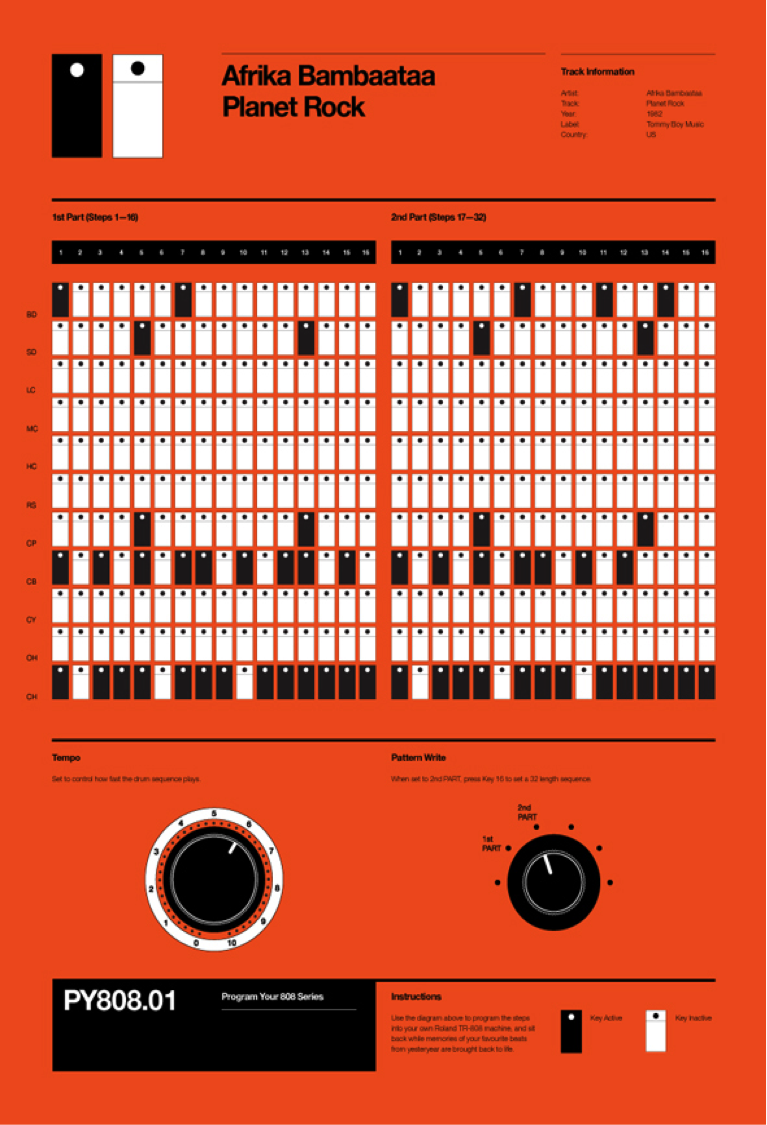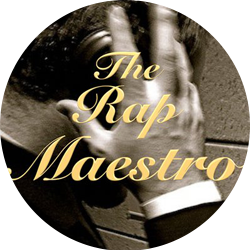—written & researched by Zach Diaz, @ZachDiazMusic
[Feel free to access a playlist that includes all of the 808 songs in this article on Spotify here.]
In the 2015 documentary film 808, drummer and prominent hip hop musician Questlove describes the 808 Drum Machine as the “rock guitar of hip hop”. This comparison could not be more accurate, as the use of the 808 has been a staple of hip hop and popular music production since its invention in 1980. As the quotation in this article’s title of the Beastie Boys’ 1998 song “Super Disco Breakin” suggests, the sonic qualities of this drum machine helped shape the sound of American popular music in the 1980s. Additionally, it continues to have an influence on modern music production through its ongoing use by some of today’s most well-known rappers and producers. By exploring the beginnings and early uses of this instrument, its usage in 80s pop and hip-hop, and frequent usage in current hip-hop, we can see the monumental influence this electronic instrument has on the sonic landscape of hip-hop’s history and culture.
The origin of the Roland TR-808 drum machine starts in 1980 when the instrument was released by the electronics manufacturer The Roland Corporation. The TR-808 model — “TR” standing for “Transistor Rhythm” — was originally designed as a stand-in for higher quality drum sets or drum machines and was to be used for recording demos by musicians. The sound of the 808 was unique to many musicians at the time due to its robotic, artificial quality. The individual drum sounds have been described as “spacey” and futuristic, and at the time of its release, the TR-808 was described by an article in an unnamed electronic magazine as having a sound similar to “marching ants”.
At first, the instrument was not received positively by many musicians and music producers, and was looked at by many as more of a toy than a useful instrument. The main criticism of the machine was that the individual drum sounds did not match the timbres of an acoustic drum set in any way. The bass drum has a low, booming ring after its initial attack (and was even the same sound used by the low toms. The other instrument sounds, such as the snare and hi-hat, have been unkindly described as thin and tinny. The cowbell sound is not even a percussive hit like the other sounds on the machine, but instead a series of two perfect fifth intervals being produced on a sawtooth wave (on the notes C-sharp 5 and G-sharp 5).
808 Cowbell sound:
https://www.youtube.com/watch?v=yJLEEjETOME
The reason for the instrument’s synthetic quality mainly stems from Roland’s desire to produce original electronic drum sounds rather than sampled sounds from a real drum set. Other higher quality drum machines, such as the Linn LM-1 (also produced in 1980) were able to create much more realistic drum sounds because of its ability to use real sampled acoustic drums. This lack of quality in the 808 also meant that the instrument was also sold at a much lower price than other competing drum machines at the time, which was very appealing to musicians on a tighter budget. One of the first uses of the TR-808 was by the Yellow Magic Orchestra, a Japanese electronic music group, who used the instrument on their song “1,000 Knives”.
“1,000 Knives” by Yellow Magic Orchestra:
The instrument eventually began to be used by American musicians several years after its initial release, and attracted a variety of producers from different genres. One of the main genres this instrument attracted was hip-hop, which was still in its developing stages during the early 1980s. Rapper Afrika Bambaataa and his group The Soul Sonic Force became interested in this instrument and used it on their hit song “Planet Rock”. The group admired the futuristic synthetic sound of the 808 and implemented the instrument in this hit single, along with a sampled melody from the popular Kraftwerk song “Trans-Europe Express”. Afrika Bambaataa states in the 2016 documentary series Hip Hop Evolution:
“I was heavy into the technopop sounds of the Yellow Magic Orchestra, Kraftwerk, and I said, yo, I wanted a sound with these electronic instruments too, like they was doing, and putting it to the funk of James Brown, Sly & The Family Stone… thus became the birth of that electro-funk sound.”
According to the producer and founder of Tommy Boy Records, Tom Silverman, “And after that there was probably a thousand records that imitated the beat that we used on that record.”
“Planet Rock” by Soul Sonic Force:
Silverman was absolutely right. After “Planet Rock” became a massive hit across the United States, hip hop and electronic musicians sought to imitate the electronic and futuristic sound. In the world of hip hop, the use of the 808 exploded throughout the rest of the 1980s. The 808 was used extensively throughout the Beastie Boys’ 1986 debut album Licensed to Ill (in songs “Brass Monkey” and “Time to Get Ill”). The instrument was also used by hip hop artists such as LL Cool J, Boogie Down Productions, Eric B & Rakim, and Big Daddy Kane. There are instances where the drum machine is used as a basis for the instrumental of a rap song, such as the Beastie Boys’ song “Brass Monkey”, and there are times where the 808 is used as a supplement to provide extra bass or percussive accents to existing drum samples in rap songs, such as Boogie Down Production’s “We In There”.
“Brass Monkey” by Beastie Boys:
“We In There” by BDP (You can hear the 808 bass around 0:40):

In order to gain a better understanding of how drum beats were created by the 808 machine, I have a diagram (originally created by graphic designer Rob Ricketts) that does a great job of showing how to input rhythms with the individual sounds of the 808 machine. Within Rob Ricketts’ series of 808 posters, there are several 808 patterns from famous pop and hip-hop songs that he portrays, but I’m going to go ahead and use his diagram of Afrika Bambataa’s “Planet Rock”, as it is one of the most influential 808 patterns, as well as the song we just talked about. The numbers towards the top of the diagram represent the measures that contain this two bar pattern, with the numbers 1-32 representing the individual 16th note subdivisions. On the left of the diagram is each individual sound of the 808, with their original names abbreviated. For each row, the black and white 808 buttons represent when each sound is played within the 2 bar pattern, with the color black representing the sound being activated and the color white representing when the sound is not playing. In the beat “Planet Rock” the sounds used are the bass drum, snare drum, clap, cowbell, and closed hi-hat, with the toms, congas, open hi-hat and cymbal sounds being omitted. Notice how the clap and snare sounds are combined by being played simultaneously in order to produce a much harder “groove” by putting more emphasis on beats 2 and 4 on each measure . The knob towards the bottom of the diagram shows where the tempo knob would be set on the instrument, which is shown as numbers 1-10 but range around 60-200 beats per minute. The beat pattern for “Planet Rock” is set around the tempo marking of 6, which translates to around 126 beats per minute.
Video of the 808 with Planet Rock being programmed:
Although the 808 did not leave the realm of hip-hop entirely, the instrument slowly fell out of frequent usage by producers, and by the 1990s had been replaced as the main source of beats with other drum sounds, such as alternative drum machines with higher quality sounds. Many producers also turned to using sampled acoustic drum sets in order to get away from the synthetic sounds of drum machines that had been popular throughout the 80s. A lot of these sampled drum breaks came from funk, R&B, and jazz records in order to portray a more organic sound and groove in their beats. This migration in hip-hop away from 808 during the 90s was meant to get away from the strict electronic sound of the instrument to something more laid back and serene. Several subgenres that became prominent during the 1990s are good examples of this, such as the Jazz rap genre, where artists such as A Tribe Called Quest and Digable Planets used jazz samples in the place of synthesizers. The G-funk subgenre also preferred samples to originally composed electronic drum beats, and artists like Dr. Dre instilled the use of samples from funk and R&B records.
By the 2000s, the use of the 808 drum machine had changed considerably from its original usage in the world of hip-hop. The sounds of the 808 found a resurgence of popularity and usage in rap in the late 90s and early 2000s. The nascent subgenre of Dirty South rap, hailing mainly from the cities of Atlanta and Houston, began to use the 808 in their beats — primarily, the sounds of the hi-hat, bass drum, and clap. Southern Rap tended to have much slower tempos than that of previous or contemporary hip-hop subgenres, with many popular recordings ranging from around 70 to 90 beats per minute. This slower tempo required an instrument that could be more rhythmically subtle than that of the 909 or other drum machines, which had sounds that were much louder in comparison. This is the hole that the 808 filled in expertly, for artists like, Lil Jon, Three 6 Mafia, and Ludacris. The sampled bass sound also became incredibly popular in this subgenre, with low melodic bass lines becoming a defining characteristic when it was constantly played on booming subwoofers by devoted fans.
“Yeah!” by Usher:
There are many other instances in which the 808 is mentioned in the lyrics of famous pop and hip-hop records. Throughout the 2000s and into the 2010s, the 808 was referenced by several prominent pop stars, from Britney Spears singing, “You got my heart beating like an 808,” in her 2007 hit “Break the Ice”, to Ke$ha asking the listener in her 2009 hit “Your Love Is My Drug,” “Do I make your heart beat like an 808 drum?” The 808 drum has also been referenced as recently as 2013 by rapper Macklemore, who states in his hit “Can’t Hold Us”: “Go hard like I got an 808 in my heart beat.” The 808 bass sound even gets a shout-out from the group Outkast in their song “The Way You Move”, where rapper Big Boi raps, “But I know y’all wanted that 808 / Can you feel that B-A-S-S bass?” Such frequent lyrical references to this instrument show that the 808 was and still is in the consciousness of popular music and culture. In fact, its booming bass sounds have become an iconic and easily identifiable marker of identity for popular musicians and their audiences.
“The Way You Move” by Outkast:
The most famous use of the 808 drum during the 2000s in rap was Kanye West’s 2008 album 808s & Heartbreak. West not only names the entire album after the instrument, but even uses it in a number of different ways on almost every track. In the track “Love Lockdown,” for example, West’s singing at the beginning is accompanied by no more than an 808 bass melody. The dark and dreary techno sounds of this album reflect that of the earlier sounds used by the Detroit Techno and Industrial scene of the 1980s and 90s. The use of the 808 in this particular way also reflects the dark mourning tones of the album’s lyrics, which discuss the untimely passing of West’s mother in 2007. West uses the sounds of the 808 drum as a musical theme to represent the heartbreak that is described throughout the album. This could be compared to the musical motifs of classical composers, like Richard Wagner or Gustav Mahler, who would use a specific chord or instrument to represent an emotion or character in their compositions.
“Love Lockdown” by Kanye West:
Currently, the 808 still has a large place in popular music and its sounds and influence continue to shape the genres of pop, EDM, and hip-hop. The genre of trap music has become increasingly popular in recent years. Trap has become a rising subgenre of hip-hop over the past decade that uses the 808’s bass and hi-hat sounds extensively. The subgenre stems mainly from Southern parts of the United States, and has even slower tempos with more rhythmically complex drum patterns. The slow tempo reflects the feelings of sedation of the drugs that were popular in such regions, and the 808 bass supports this by usually providing a sedate bass line in a minor key. The hi-hats can be incredibly rhythmically complex, sometimes consisting of thirty-second and sixteenth-triplet note patterns. Prominent artists of the trap subgenre include producers such as Zaytoven and Metro Boomin’, who make beats for rappers like Desiigner, Future, Lil Yachty, and 21 Savage. Many of the artists who use 808s have received a considerable amount of attention and praise in the realm of mainstream pop, earning coveted spots in the Billboard Hot 100 (such as Desiigner’s “Panda” reaching #1 on the Billboard Hot 100 just last year). This shows that the 808 still has a presence in popular music, especially Top 40 pop, over thirty-five years after its initial release by Roland.
“March Madness” by Future (produced by 808 Mafia): https://www.youtube.com/watch?v=tQX9RZoVk0s
Since the construction of the original TR-808 Rhythm Composer in 1980, this machine has influenced almost every facet of popular music since. From the electro-funk grooves of the Soul Sonic Force to the booming 808 bass lines of current Top 40 hits, it is safe to assume that this instrument will continue to shape the sound of popular music in America and throughout the globe for years to come.
Further Reading/Other Sources:
Dunn, Alex, dir. 2015. 808. You Know Films. Download, Atlantic Films, 2016. Accessed December 5, 2016. http://808themovie.com/.
George, Nelson, dir. 2012. All Hail The Beat. Focus Forward Films. Accessed December 5, 2016. https://vimeo.com/40094608.
Massey, Graham. “Roland TR-808: The drum machine that changed music” (video). Today (video and audio podcast). BBC Radio 4, March 21, 2014. Accessed December 4, 2016. http://www.bbc.com/news/entertainment-arts-26682781
Norris, Chris. “The 808 Heard Round the World.” New Yorker, August 13, 2015. Accessed December 2, 2016. http://www.newyorker.com/culture/culture-desk/the-808-heard-round-the-world.
TR-808 Operation Manual. Roland Corporation, 1980. http://cdn.roland.com/assets/media/pdf/TR-808_OM.pdf
Wang, Oliver. “Hear the Drum Machine Get Wicked.” Journal Of Popular Music Studies 26, no. 2/3 (June 2014): 220-225. Accessed December 2, 2016. http://web.a.ebscohost.com.steenproxy.sfasu.edu:2048/ehost/pdfviewer/pdfviewer?sid=04b48a72-8dc2-4108-8379-ba098a1a3a46%40sessionmgr4006&vid=0&hid=4101.
Werner, Kurt. “The Roland TR-808 and the Tale of the Marching Anteaters.” Ethnomusicology Review 20 (2015). Accessed December 3, 2016. http://ethnomusicologyreview.ucla.edu/content/roland-tr-808-and-tale-marching-anteaters.
Wheeler, Darby, dir. Hip-Hop Evolution. Banger Films, 2016. Accessed December 2, 2016. https://www.netflix.com/.

